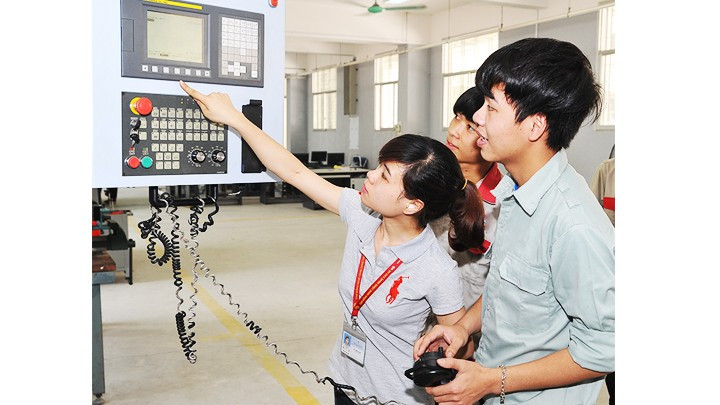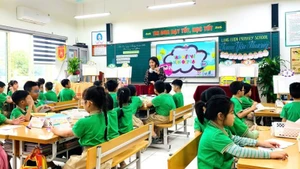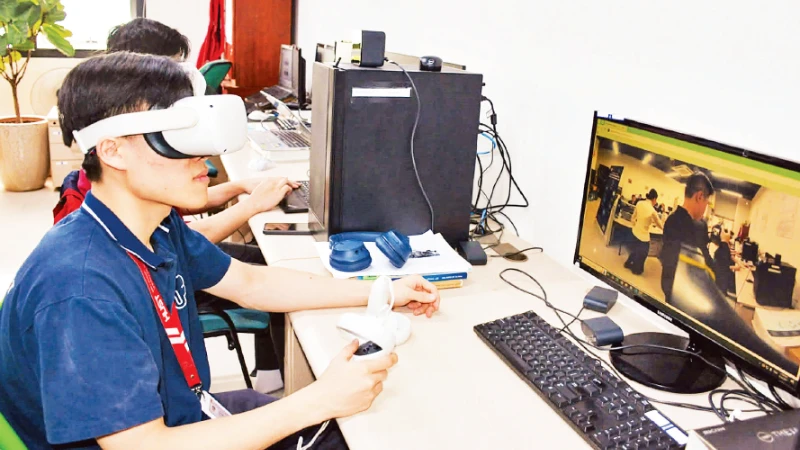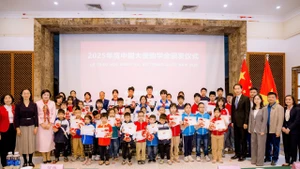Opportunities from new policies
Bui Viet Thanh Tung, a final-year student at the Faculty of Electrical and Electronic Engineering, University of Technology under Vietnam National University, Hanoi, spends his days diligently in the laboratory. He is developing sensor and electromagnetic devices with the hope that they can be applied to missions for protecting Vietnam's maritime sovereignty.
Tung realised that vast opportunities are opening as the government introduces breakthrough policies for science and technology development. He shared: “The government is focusing on developing scientific and technological human resources for key industries. The semiconductors and microchips industry alone need around 10,000 university-level personnel each year, so I see great potential for employment or pursuing further research.”
Pham Hai Anh, a student from the Faculty of Electronics and Telecommunications at the same university, shares a similar perspective: “Previously, I thought I would just join a company after graduation. But after four years of university, my career direction has changed. The government is now heavily investing in research institutes, offering scholarships to students and those with groundbreaking research. So, I hope to do research and continue to pursue higher education.”
Attracting more technological talents and reforming the training of young domestic human resources are becoming an urgent requirement for Vietnam. Professor Dr Chu Duc Trinh, Rector of the University of Technology under Vietnam National University, Hanoi, said: “We issue policies to encourage and support outstanding and talented students to join the university’s training programmes through scholarships. Starting from 2025, we will comprehensively invest in our master’s and doctoral programmes. All master’s and PhD students will be fully exempted from tuition fees. Each master’s student will receive a monthly allowance of 5 million VND, and each PhD student will receive 7 million VND. Each year, we will allocate about 10–20 billion VND for this activity.”
Meanwhile, Hanoi University of Science and Technology has allocated 70 billion VND to the learning encouragement scholarship fund for the 2024–2025 academic year. Accordingly, Type C scholarships (for good students) are equivalent to the tuition fees students must pay. Type B (for excellent students) is 1.2 times the Type C amount, and Type A (for outstanding students) is 1.5 times the Type C scholarship. Additionally, there are Tran Dai Nghia scholarships awarded to students from disadvantaged backgrounds; international student exchange scholarships funded by the university for short-term study and internships abroad at partner institutions (the 2024 budget for this scholarship source is 5 billion VND), as well as scholarships from multilateral and bilateral cooperation programmes of the university.
Assoc. Prof. Dr Nguyen Anh Dung, Deputy Director General of the Higher Education Department under the Ministry of Education and Training, remarked: "Resolution No. 57 is a major policy, reflecting the strong determination of the Party and the State to elevate Vietnam into a prosperous and developed nation in the new era. For the education sector, we affirm that this is a valuable opportunity. Reality has shown that no country can develop science, technology, innovation, and digital transformation without a strong higher education foundation. Therefore, higher education must receive greater investment so that we can adequately prepare high-quality human resources to serve the nation’s development."
Planning of the Higher Education Institution Network for the 2021–2030 period, with a vision to 2050, aims to develop Hanoi University of Science and Technology, Vietnam National University, Hanoi, and Vietnam National University, Ho Chi Minh City into leading higher education institutions in Asia. It also envisions elevating Hue University and Da Nang University to the status of national universities. Under the plan, Thai Nguyen University will be upgraded and its development space expanded to serve the midland and northern mountainous region. Regional universities will also be upgraded and further developed in the North Central, South Central, Central Highlands, and Mekong Delta regions, with core institutions including Vinh University, Nha Trang University, Tay Nguyen University, Can Tho University, and several other universities in each region. Additionally, conditions will be prepared for Tay Bac (Northwest) University to be developed into a regional university after 2030.
Higher education institutions will follow a research-oriented model, focusing on talent development, high-quality training, and postgraduate education linked to scientific research and innovation. These universities will undertake national strategic missions with a focus on fundamental sciences, engineering, technology, and other priority fields based on the core strengths of each university and region.
The Ministry has recently announced the Planning of the Higher Education Institution Network for the 2021–2030 Period, with a vision to 2050. According to Deputy Minister Hoang Minh Son, the key highlight of this plan lies in its strategy for human resource development, especially high-quality human resources.
The plan is expected to have a positive impact on higher education institutions, allowing them to expand their development space and receive increased investment in infrastructure. Specifically, regional universities, national universities, and key institutions will see improvements in capacity, quality, and scale.
The planning prioritises key areas such as STEM (Science, Technology, Engineering, and Mathematics), teacher training, and health-related disciplines.
The goal is to consolidate, invest in, and modernise the higher education system such that by 2030, no institution remains below standard. Institutions that fail to meet the standards will face restructuring, mergers, or even dissolution.
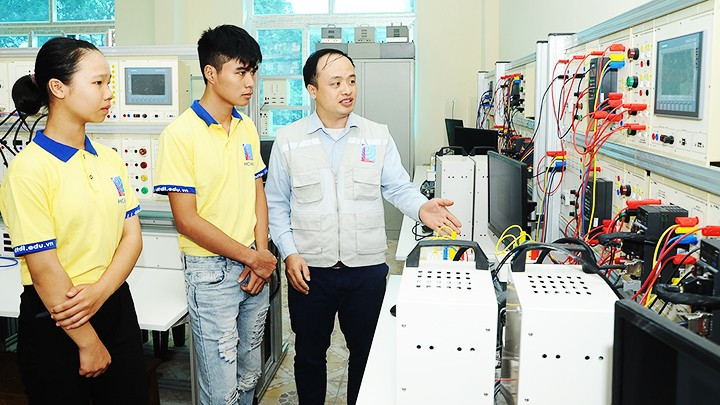 |
| Practical training session of students at Hanoi College of Electronics and Refrigeration. (Photo: NGUYEN HAI) |
The collaboration between educational institutions and enterprises is becoming a key strategy in the training of high-quality human resources. This connection is reflected in various aspects such as enterprises frequently working with experts from educational institutions to define specialised research directions; they engaging with students to help them better understand job expectations and recruitment orientation; schools tailoring their training programs to meet enterprise demands in terms of quantity, quality, and skills; industry experts participating in guiding students during practical sessions; students undertaking internships and gaining real-world experience at enterprises; and businesses taking part in thesis defences to interview and recruit graduates.
Ho Khanh Le, a digital transformation expert, emphasised that collaboration between institutional facilities and enterprises is essential in human resource training. This is extremely important because businesses need to be involved from the beginning of the training process to ensure that the workforce meets their actual needs. Currently, several schools have already integrated enterprise demands into their training programmes. The coordination, career orientation, and support provided by businesses through demand-based training are proving to be effective.
According to Associate Professor Dr Nguyen Phong Dien, Vice President of Hanoi University of Science and Technology, to train high-quality human resources, cooperation between higher education institutions and enterprises is essential. Government investment is necessary in order to realise this strategy. Businesses will work with university experts to carry out research projects. This enhances the professional and practical skills of lecturers and students. Moreover, the research products will serve the needs of the enterprises.
It is known that at Hanoi University of Science and Technology, through partnerships with businesses, students receive between 5 to 7 billion VND in scholarships annually, funded by individuals, organisations, and enterprises both domestically and internationally. These include scholarships from Sumitomo, Toyota, Toshiba, Nitori, Samsung, LG, Lotte, Posco, Merali, EVN, Petrolimex, CC Foundation, MB Bank, PTSC, and others.
Meanwhile, Professor Dr Chu Duc Trinh, Rector of the University of Engineering and Technology, shared: “We have successfully created a collaboration channel between the university, research institutes, and businesses. Every year, businesses regularly invest in supporting students through scholarship programs. We hope many other universities in Vietnam will adopt similar partnership models so that universities can develop into research centres.”
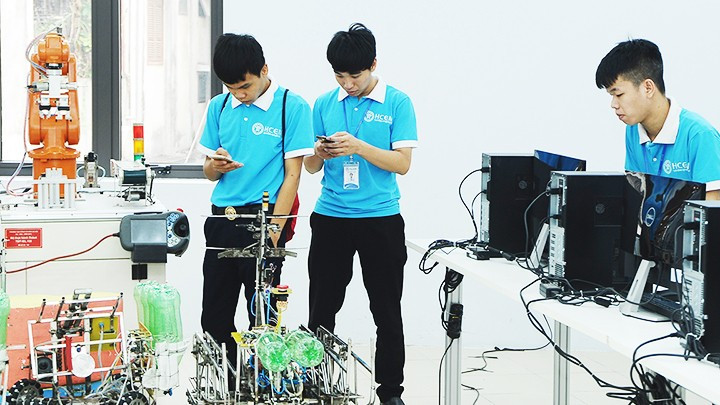 |
| A class session of students at Hanoi College for Electro-Mechanics. (Photo: BAC SON) |
Removing the “financial bottleneck” in the semiconductor industry
In reality, partnerships also help address one of the biggest challenges for domestic educational institutions including the investment in infrastructure, equipment, and testing environments for electronic circuit design, which crucial for students, educators, and young engineers. Currently, lecturers and students at Hanoi University of Science and Technology (HUST) have developed several types of electronic devices such as voltage stabilisation sensors, distance sensors, and electroencephalogram (EEG) acquisition systems. Investment in just the design and testing rooms for semiconductor circuits has already reached around 130 billion VND. The university estimates that at least 1 trillion VND is needed to meet the basic requirements for labs and practical training in semiconductor education.
The first stage in producing a semiconductor chip is design. On the surface, it may seem to only require a computer and software, but that’s just the initial investment. Since technology evolves constantly, equipment must be regularly upgraded to keep up, which requires significant funding. Producing a chip typically involves at least three to four iterations, known as research phases. Each phase can cost hundreds of millions of VND. Associate Professor Dr Pham Nguyen Thanh Loan, Deputy Head of the Faculty of Electronics, School of Electrical and Electronic Engineering, noted: “A chip may be only 1mm x 2mm, but each production cycle costs over ten thousand USD — equivalent to several hundred million VND. And that process must be repeated four times. Furthermore, integrating the chip into a circuit board requires designing the board itself and sourcing compatible external components. Those costs are still minor compared to the production costs. Then there’s the intellectual labour — paying a PhD candidate, plus three to four master’s students, and the many bachelor’s students involved in the project.”
At Hanoi University of Science and Technology (HUST), designed electronic products are typically sent to the Republic of Korea or Taiwan (China) for manufacturing. Once the chip is produced, students conduct testing and verification of its functions. This entire process is both time-consuming and costly.
Master Do Quang Huy from the School of Electrical and Electronic Engineering shared: “On average, it takes about 3 to 6 months to produce a complete chip. Then, if any function is found to be suboptimal, we’ll need another 6 months for redesign and another 6 months to create a new version. Each time a chip is produced and sent overseas, the cost averages 10,000 to 15,000 USD.”
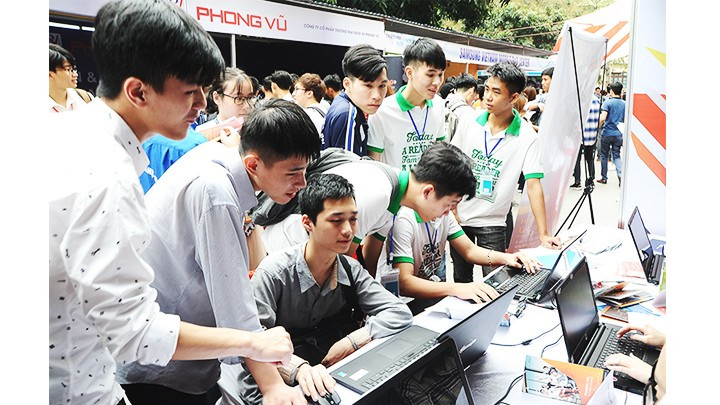 |
| A student from the University of Technology explores job opportunities at a company. (Photo: HAI ANH) |
Moreover, semiconductor laboratories are not one-time investments that can be used indefinitely. For example, a cleanroom used for materials fabrication initially required an investment of 100 billion VND, but now, to meet training demands, an additional 500 billion VND is needed. Associate Professor Dr Nguyen Phong Dien, Vice President of Hanoi University of Science and Technology, noted: “One concern is that if all equipment is imported and cannot be manufactured or assembled domestically, then we become entirely dependent on foreign sources for maintenance and repairs. Additionally, maintaining the stability of a cleanroom consumes a significant amount of electricity. Therefore, appropriate investment is crucial to ensure efficient operation.”
With the Politburo’s Resolution No.57, substantial resources will be allocated for infrastructure investment and policies to attract talented individuals starting from the university level. In line with the national plan to train 50,000 semiconductor engineers over the next five years — as part of the Semiconductor Human Resource Development Programme until 2030, with a vision to 2050, as approved by the prime minister — the Ministry of Education and Training is currently expediting the finalisation of the programme.
Associate Professor Dr Nguyen Anh Dung stated: “We are striving to coordinate and maximise the resources of leading universities and have formed alliances among educational institutions to engage in training for the semiconductor industry. In fact, alliances have already been established in preparation for this. The government has designated four national-level shared laboratories, with funding from the state budget. These labs will operate on a national scale to address major tasks and support the entire system. In addition, approximately 18 higher education institutions are expected to receive funding for basic or foundational laboratories. These institutions will serve as satellite hubs to collectively utilise and optimise infrastructure and facilities for training high-quality human resources in general and for developing the semiconductor workforce in particular, as approved by the government.”
According to the draft proposal on Human Resource Training for the Development of High Technology in the 2025–2035 period, with orientation toward 2045, the scale of advanced-level training in STEM fields will be significantly expanded by 2030, especially in basic sciences and disciplines related to digital technology, artificial intelligence, and biotechnology.
The proposal sets a goal that 35% of learners at each education level will pursue studies in STEM fields, of which at least 2.5% will be in basic sciences and 18% in fields related to digital technology.
